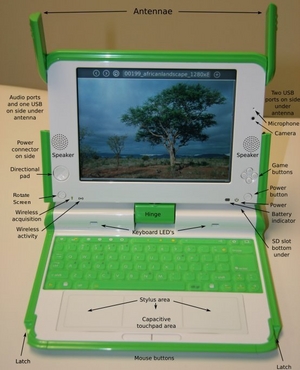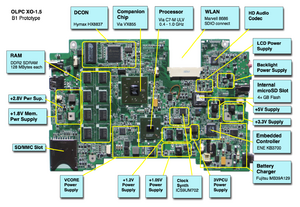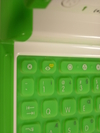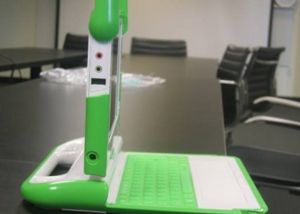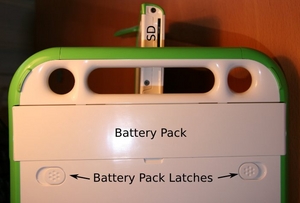Especificaciones Hardware XO-1.5: Difference between revisions
(New page: {{Translation | lang = es | source = XO-1.5 | version = 219819}} {{Ongoing Translation}} {{TOCright}} ==The XO-1.5 hardware refresh== The XO-1.5 laptop is the central focus of One Laptop...) |
No edit summary |
||
| Line 3: | Line 3: | ||
{{TOCright}} |
{{TOCright}} |
||
==La actualización del hardware XO-1.5== |
|||
==The XO-1.5 hardware refresh== |
|||
La laptop XO-1.5 es el foco central de One Laptop Per Child en el 2009. |
|||
Una actualización del [[XO-1]] está en marcha. En nuestro esfuerzo contínuo para manterner un precio bajo, OLPC está actualizando el hardware para sacar ventaja de las últimas tecnologías en componentes. Ésta actualización (Generación 1.5) es un proyecto separado de [[Gen 2.0]], y va a continuar usando el mismo diseño industrial y baterías que la Gen 1. El objetivo del diseño es proveer una actualización general al sistema dentro del mismo DI (diseño industrial) y apariencia externa. |
|||
En términos generales, la meta es mantener el precio y el bajo consumo eléctrico del Gen 1 XO-1; haciendo al mismo tiempo al procesador más activamente "haragán" (ahorrando batería). Es muy probable que alcancemos las metas. |
|||
Overall, the target is to match the Gen 1 XO-1 in power consumption while making aggressive suspend easier, and in price (while changing to components which are more likely to decrease in price). It is likely that both goals can be met. |
|||
También esperamos que las máquinas Gen 1.5 se entreguen con un nuevo OS: [[F11_for_1.5|new software release]], basado en Fedora 11, e incluyendo tanto Sugar como GNOME. |
|||
== Specifications == |
== Specifications == |
||
Revision as of 11:58, 9 November 2009
| Traducción de XO-1.5 | original |
| XO-1.5/translations +/- | cambios |
- This is an on-going translation
La actualización del hardware XO-1.5
La laptop XO-1.5 es el foco central de One Laptop Per Child en el 2009.
Una actualización del XO-1 está en marcha. En nuestro esfuerzo contínuo para manterner un precio bajo, OLPC está actualizando el hardware para sacar ventaja de las últimas tecnologías en componentes. Ésta actualización (Generación 1.5) es un proyecto separado de Gen 2.0, y va a continuar usando el mismo diseño industrial y baterías que la Gen 1. El objetivo del diseño es proveer una actualización general al sistema dentro del mismo DI (diseño industrial) y apariencia externa.
En términos generales, la meta es mantener el precio y el bajo consumo eléctrico del Gen 1 XO-1; haciendo al mismo tiempo al procesador más activamente "haragán" (ahorrando batería). Es muy probable que alcancemos las metas.
También esperamos que las máquinas Gen 1.5 se entreguen con un nuevo OS: new software release, basado en Fedora 11, e incluyendo tanto Sugar como GNOME.
Specifications
The definitive XO-1.5 laptop specification is not yet available, however in many respects it is comparable to the XO-1 spec (pdf).
Physical dimensions
- Approximate dimensions: 242mm × 228mm × 32mm (see drawing to the right for detailed dimensions)
- Approximate weight:
- XO laptop with LiFePO4 battery: 1.45KG (~3.20lbs); UNREVIEWED
- XO laptop with NiMH battery: 1.58KG (~3.48lbs); UNREVIEWED
- Configuration: Convertible laptop with pivoting, reversible display; dirt- and moisture-resistant system enclosure; no fan.
Core electronics
- A photo of the XO 1.5 Motherboard is available with annotations.
- CPU: Via C7-M Ultra Low Voltage x86-compatible processor with 128KB L2 cache;
- No datasheet is publicly available. All the chip data sheets should be publicly available when this laptop reaches production. At this time, they are still being written and reviewed for release.
- CPU clock speed: 400 MHz (1.5 W) to 1GHz (5 W), variable. The clock may be throttled back automatically if necessary to meet thermal constraints; Clock speed changes happen very quickly, as does dropping the processor voltage (0.728V in C3/C4, as compared to 0.798V in C0).
- An Intel-compatible instruction set (including MMX, SSE, SSE2 & SSE3)
- Companion chips: Via VX855 provides memory interface, a 3D graphics engine, an HD video decoder, USB, SDIO, and other system interface and management functions
- No datasheet is publicly available
- The VX855 is a minor incremental step from the 800/820. Here is the public manual for the VX800/820, and for the included Chrome9 core 2D graphics and 3D and video.
- Embedded controller: ENE KB3700 or ENE KB3700B;
- DRAM memory: 1 GiB dynamic RAM; data rate: DDR2 SDRAM;
- BIOS: 1 MiB SPI-interface flash ROM;
- Open Firmware used to load the operating system;
- Mass storage: 4 GiB NAND flash in an internal microSD card (not user-changeable without opening the unit with a screwdriver). Also, one externally accessible SD card slot as in the original XO.
- Drives: No rotating media.
Display
- Main article: Display
- Liquid-crystal display: 7.5” dual-mode TFT display;
- Viewing area: 152.4 mm × 114.3 mm;
- Two "modes" depending on lighting conditions:
- (1) Grayscale (B&W) reflective mode: for outdoor use—sunlight-readable; primarily lit from the front by ambient light; high-resolution (200 DPI), 1200(H) × 900(V) grayscale pixels; power consumption 0.1–0.2Watts;
- (2) Color, backlight mode: for indoor use; primarily lit from behind by the LED backlight; built in sub-pixel sampling of the displayed color information results in a perceived resolution of approximately 984(H) × 738(V); power consumption 0.2–1.0Watts;
- The display-controller chip (DCON) with memory that enables the display to remain live with the processor suspended. The DCON also formats data for the display.
- This Liquid-crystal display is the basis of our extremely low power architecture. The XO is usable while the CPU and much of the motherboard is regularly turned off (and on) so quickly that it's imperceptible to the user. Huge power savings can perhaps be harvested in this way (e.g. by turning stuff on the motherboard off when it's not being used (if even for a few seconds), while keeping the display on).
- Note: web browser images are currently scaled up so that an image of very roughly [800 × 600] fills up the browser window.
Gen 1.5 will continue with the existing display, although OLPC is working with PixelQi to try to improve the brightness and efficiency of the screen.
Integrated peripherals
- Keyboard: 80+ keys, 1.0mm stroke; sealed rubber-membrane key-switch assembly;
- Keyboard Layouts
- Layout pictures: English, Arabic, Thai, West African (Nigeria), Portuguese, Spanish, Amharic, French, Urdu, Cyrillic, Turkish (not final), Nepali, Mongolian, Kazakh, Devanagari, Uzbek, Pashto, Dari, Pulaar (Fula), Italian
- Gamepad: Two sets of four-direction cursor-control keys;
- Touchpad: Capacitance touchpad
- Audio: HD Audio compatible audio subsystem; Internal stereo speakers and amplifier; internal monophonic microphone; jacks for stereo external headphones and microphones;
- Conexant CX20582 codec and maybe Analog Devices SSM2302 for audio amplification? UNREVIEWED
- Camera: integrated color video camera; 640 x 480 resolution at 30 FPS; independent (and undefeatable by software) display of microphone and camera recording status; the camera and device driver support disabling AGC and automatic color balancing, to enable its use as a photometric sensor for educational applications;
- Wireless Networking: Integrated 802.11b/g (2.4GHz) interface; dual adjustable, rotating antennas support diversity reception;
- Marvell Libertas wireless chip, 88W8686, with SDIO interface, on removable module; remains powered while the laptop suspends, waking the laptop if a packet addressed to it arrives. It is likely that early production models will not directly support 802.11s (i.e. forwarding mesh packets while the interface is asleep), but we are working with Marvell on several different 802.11s solutions.
- Status indicators: Power, battery, and WiFi (2), visible with lid open or closed; Microphone In-Use, and Camera In-Use, visible when lid is open.
External connectors
- DC power: 6mm (1.65mm center pin) connector; 11 to 18 V input usable, –32 to +40V input tolerated; power draw limited to 25 W; - see power connector dimensions at Battery and power.
- Headphone output: standard 3.5mm 3-pin switched stereo audio jack;
- Microphone input: standard 3.5mm 3-pin switched stereo microphone jack; selectable 2V DC bias; selectable sensor-input mode (DC or AC coupled);
- USB: Three Type-A USB 2.0 connectors; Up to 1A power supplied (total);
- Flash Expansion: SD Card slot.
Battery
- Pack type: 2 or 4 cells LiFePO4; or 5 cells NiMH, approx. 6V series configuration (subject to change);
- Capacity: 16.5 Watt-hours (NIMH), 22 Watt-hours (LiFeP);
- Fully-enclosed “hard” case; user removable;
- Electronics integrated with the pack provide:
- Identification;
- Battery charge and capacity monitoring chip (Maxim DS2756 data sheet);
- Thermal and over-current sensors along with cutoff switch to protect battery;
- Minimum 2,000 charge/discharge cycles (to 50% capacity of new).
- Power Management will be critical
See Laptop Batteries or more information.
BIOS/loader
- Open Firmware (including hardware initialization and fast resume).
- Panasonic ML1220 battery
Environmental specifications
- Temperature: UL certification planned to 45C in Q32007, pending 50C certification in mid-2008; UNREVIEWED
- Humidity: UL certification planned to IP42 (perhaps higher) when closed, the unit should seal well enough that children walking to and from school need not fear rainstorms and dust; UNREVIEWED
- Maximum altitude: –15m to 3048m (14.7 to 10.1 PSIA) (operating), –15m to 12192m (14.7 to 4.4 PSIA) (non-operating); UNREVIEWED
- Shock 125g, 2ms, half-sine (operating) 200g, 2ms, half-sine (non-operating); UNREVIEWED
- Random vibration: 0.75g zero-to-peak, 10Hz to 500Hz, 0.25 oct/min sweep rate (operating); 1.5g zero-to-peak, 10Hz to 500Hz, 0.5 oct/min sweep rate (nonoperating); UNREVIEWED
- 2-3mm plastic walls (1.3mm is typical for most systems).
Regulatory requirements
- The usual US and EU EMI/EMC (electromagnetic-interference and electromagnetic-compatibility) requirements will be met;
- The laptop is intended to meet IEC 60950-1, EN 60950-1, and CSA/UL 60950-1 specifications. It will also comply with UL 1310 and UL 498. In order to guarantee the safety of children using the laptop, it passes ASTM F 963;
- The external power adapter complies with IEC, EN, and CSA/UL 60950-1;
- The removable battery pack complies with IEC, EN, and CSA/UL 60950-1 and UL 2054;
- RoHS (Restriction of Hazardous Substances Directive – EU) compliant.
Laptop Development Schedule
Early versions of the hardware (bare board) should be available for driver development at the end of May 2009; see XO1.5 Bringup and XO 1.5 A1. A larger number of prototype laptops (several hundred) for software development and testing will become available around the end of August 2009. The OLPC contributors program will be the preferred way of requesting a Gen 1.5 machine for testing your software for compatibility or development. We hope to use the contributors program to ensure Gen 1.5 support for the wide variety of application and OS solutions created for Gen 1.0.
Serial Adapter
In order to conserve parts/space, while the motherboard does provide a serial port for debugging, it does not provide voltage translators to fully implement the RS-232 protocol. Thus a 3.3V TTL to RS-232 (or USB) Adapter is needed.
See also
- OLPC announcement of Gen 1.5 on April 17 2009.
- XO-1 Hardware specification
- Hardware Testing: Safety Certifications and Robustness
- Hardware and Category:Hardware
